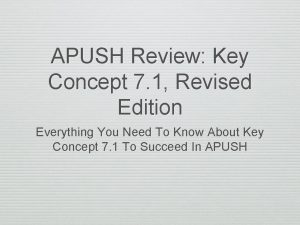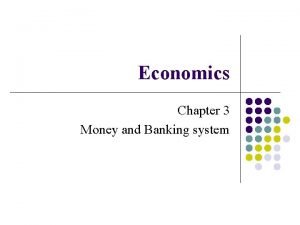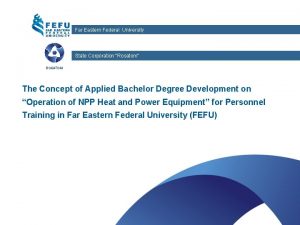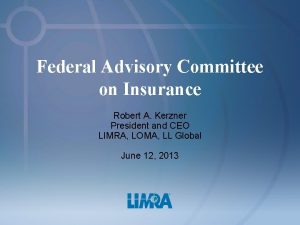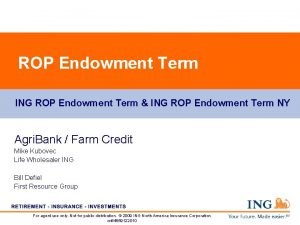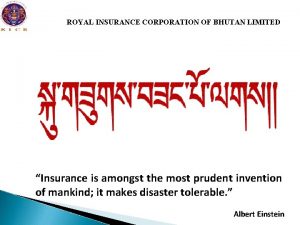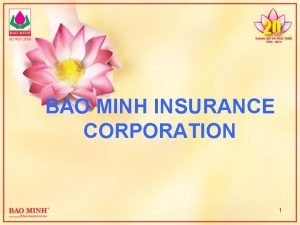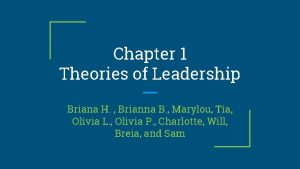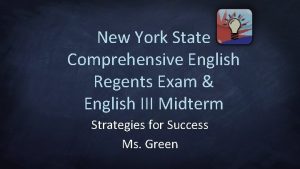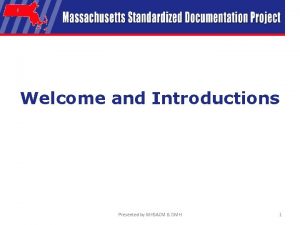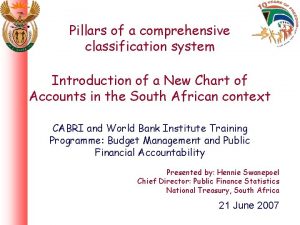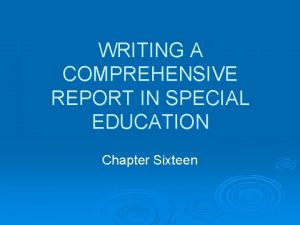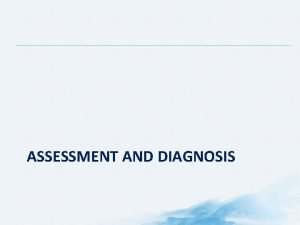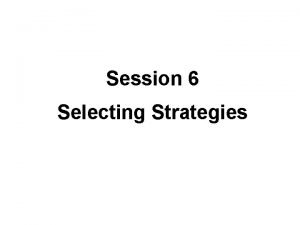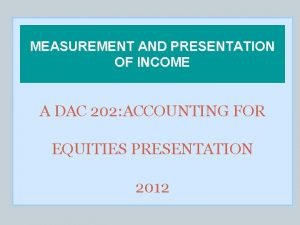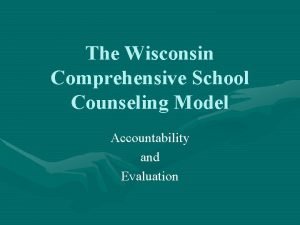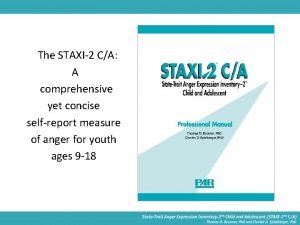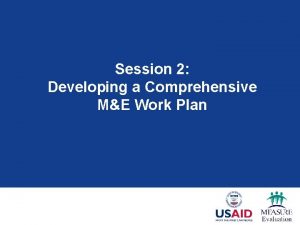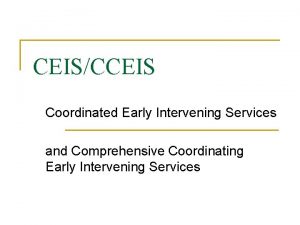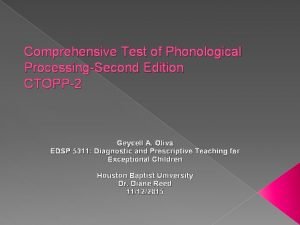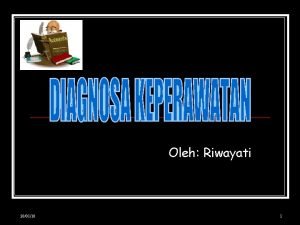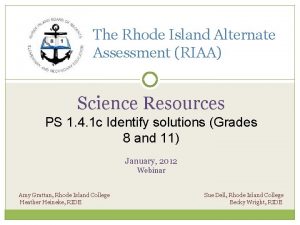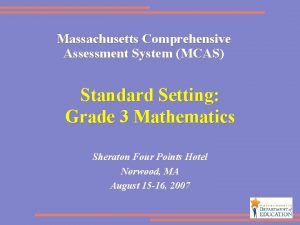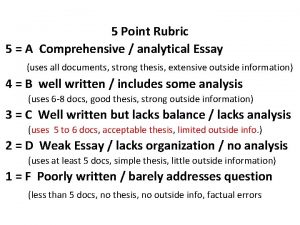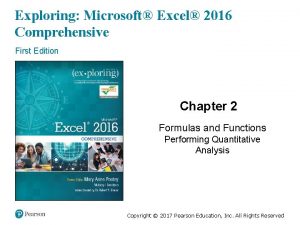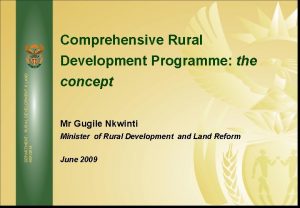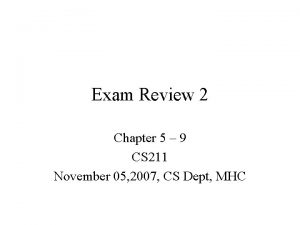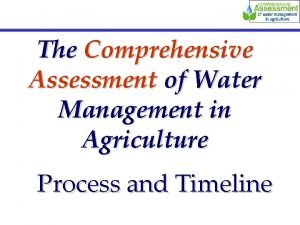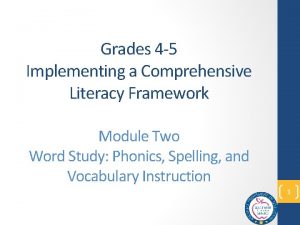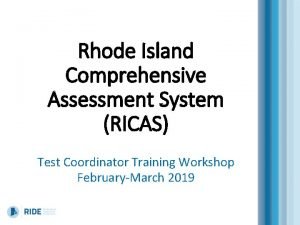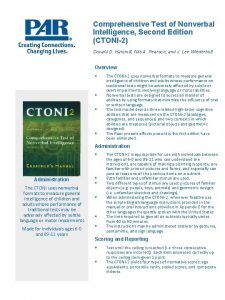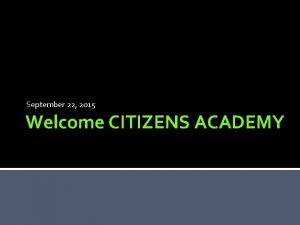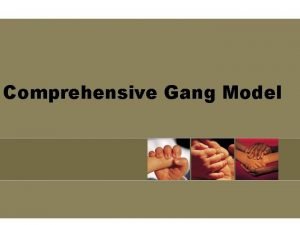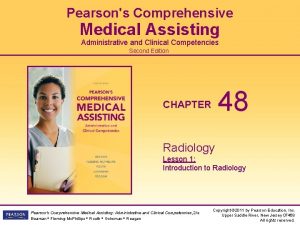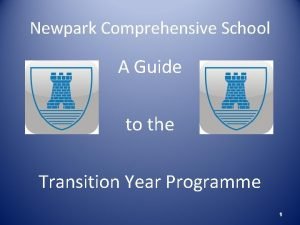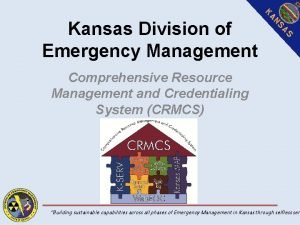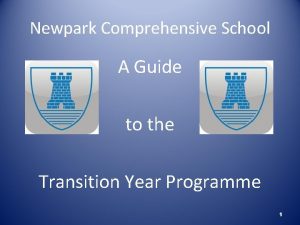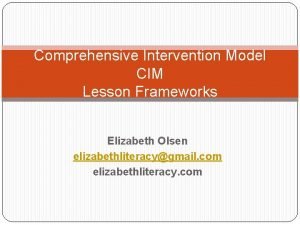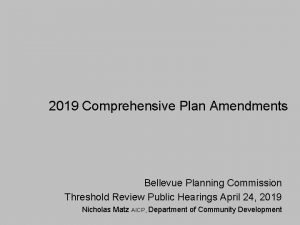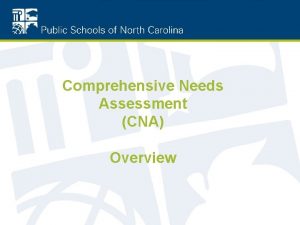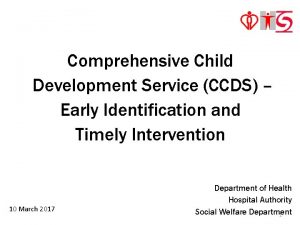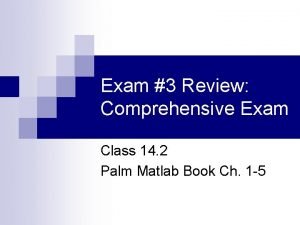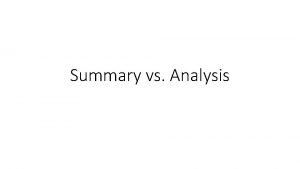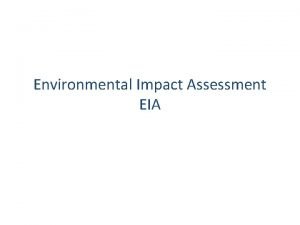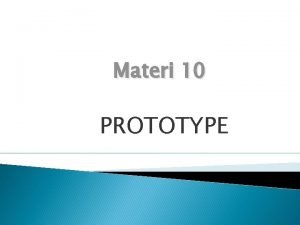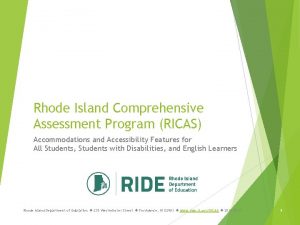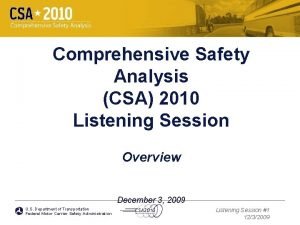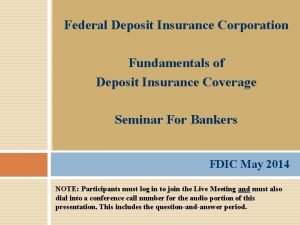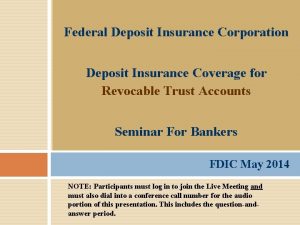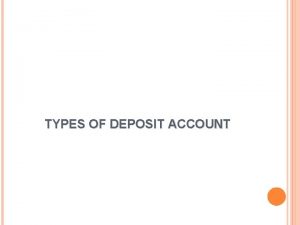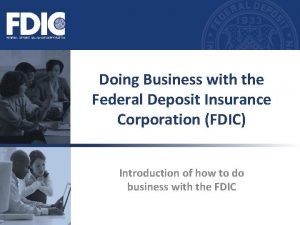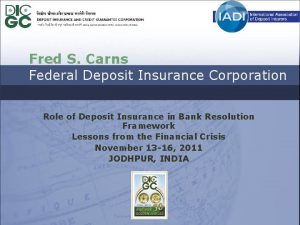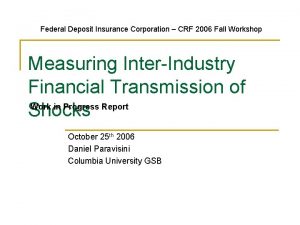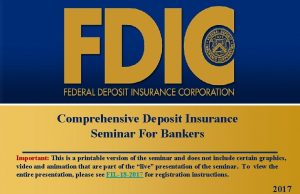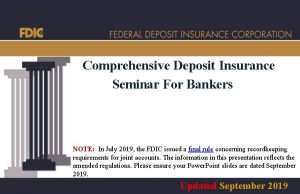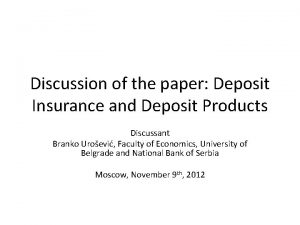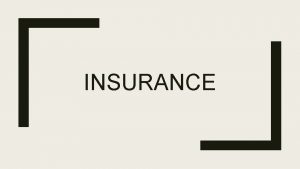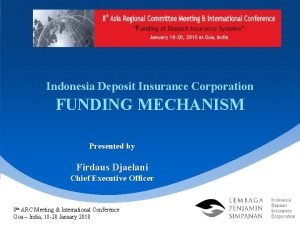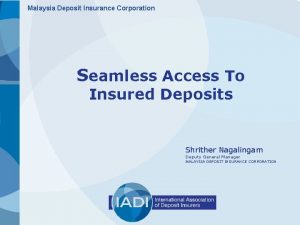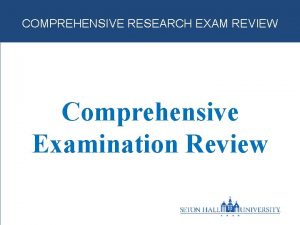Federal Deposit Insurance Corporation Comprehensive Seminar On Deposit




















































































- Slides: 84

Federal Deposit Insurance Corporation Comprehensive Seminar On Deposit Insurance Coverage For Bankers 2013

Outline Part 1 – General Principles Part 2 – Ownership Categories Part 3 – Ownership Category Requirements Part 4 – Fiduciary and Agency Accounts Part 5 – Bank Mergers and Failures Part 6 – Deposit Insurance Coverage Resources 2 2013 Comprehensive Seminar on Deposit Insurance Coverage

Seminar on Deposit Insurance Coverage PART 1 GENERAL PRINCIPLES 3 2013 Comprehensive Seminar on Deposit Insurance Coverage

Part 1 General Principles Basic Insurance Coverage • The Standard Maximum Deposit Insurance Amount (“SMDIA”) is $250, 000. Under 12 C. F. R. § 330. 1(n), adjusted pursuant to subparagraph (F) of section 11(a)(1) of the FDI Act (12 U. S. C. 1821(a)(1)(F)). • Coverage includes principal and interest earned up to the date of a bank’s closing. 4 Important! The Dodd-Frank Act permanently increased the SMDIA to $250, 000. 2013 Comprehensive Seminar on Deposit Insurance Coverage

Part 1 General Principles Basic Insurance Coverage • Coverage includes principal and interest earned up to the SMDIA. Jane Smith Balance Principal Amount Accrued Interest $ 248, 000 3, 000 Total Insured $ 251, 000 $ 250, 000 Uninsured $ 1, 000 5 2013 Comprehensive Seminar on Deposit Insurance Coverage

Part 1 General Principles FDIC Insures Only Bank Deposits Checking Accounts NOW Accounts Savings Accounts Money Market Deposit Accounts (“MMDAs”) Certificates of Deposit FDIC Does Not Insure Non-deposit Products Stocks, Bonds, Municipal Bonds and Other Securities Mutual Funds (money market mutual funds and stock, bond, or other security mutual funds) Annuities Insurance Products Safe Deposit Box Contents U. S. Treasury Bills, Bonds or Notes 6 2013 Comprehensive Seminar on Deposit Insurance Coverage

Part 1 General Principles Coverage Per Depositor • Deposit Insurance Coverage is calculated per depositor (owner of the deposit account). • A depositor can be the following: – a person – a business/organization – a government entity • A depositor does not have to be a citizen or resident of the United States to be eligible for deposit insurance coverage. 7 2013 Comprehensive Seminar on Deposit Insurance Coverage

Part 1 General Principles Death of an Account Owner The death of an account owner will in most cases reduce the amount of deposit insurance coverage. • If an account owner dies, for the purpose of calculating deposit insurance coverage, the FDIC provides a six-month grace period during which the account will be insured as if the account owner had not died. • After the six-month grace period, the funds will be insured according to the ownership category in which the deposits are held. 8 2013 Comprehensive Seminar on Deposit Insurance Coverage

Part 1 General Principles Coverage Per Bank Deposit insurance coverage is also calculated per bank: • Deposits placed in the branch offices of a bank with the same charter are added together. • Deposits placed in separately chartered banks are separately insured. • Deposits in separate branches of a bank are not separately insured even if the branches are in different states. 9 2013 Comprehensive Seminar on Deposit Insurance Coverage

Part 1 General Principles Deposit Account Records • In the event of a bank failure, the FDIC relies on bank deposit account records to determine ownership. • Examples of bank deposit account records may include: – – Account ledgers Signature cards Certificates of Deposit Corporate resolutions in possession of the IDI authorizing the accounts – Other books and records of the bank including computer records that relate to the bank’s deposit-taking function 10 2013 Comprehensive Seminar on Deposit Insurance Coverage

Part 2 General Principles Coverage Per Ownership Category Deposit insurance coverage is also calculated per ownership category. • Deposits that a person or entity maintains in different ownership categories at one bank are separately insured up to the insurance limit. • Deposits that a person or entity maintains in the same ownership right and capacity at the same bank are added together and insured up to at least $250, 000. 11 2013 Comprehensive Seminar on Deposit Insurance Coverage

Seminar on Deposit Insurance Coverage PART 2 OWNERSHIP CATEGORIES 12 2013 Comprehensive Seminar on Deposit Insurance Coverage

Part 2 Ownership Categories Questions every bank employee must ask and answer to calculate FDIC deposit insurance coverage: 1) Who owns the funds? 2) What ownership category is the depositor eligible to use or attempting to use? 3) Does the depositor meet the requirements of that category? 13 2013 Comprehensive Seminar on Deposit Insurance Coverage

Part 2 Ownership Categories Who Owns the Funds? • Calculating the amount of FDIC deposit insurance coverage begins with determining who owns the funds. • FDIC deposit insurance is based on the ownership of the deposit funds—also referred to as a “right and capacity” or an ownership category. IMPORTANT! Deposit insurance coverage is NOT calculated on a per account basis; it is based on the owner and ownership category in which the funds are held. 14 2013 Comprehensive Seminar on Deposit Insurance Coverage

Part 2 Ownership Categories An “ownership category, ” also referred to as a “right and capacity” in the deposit insurance regulations, is defined by either a federal statute or by an FDIC regulation and provides for separate FDIC deposit insurance coverage. If a depositor can meet the rules for a specific category, then their deposits will be entitled to both of the following: 1) Up to the SMDIA in deposit insurance coverage that is provided for under the ownership category, and 2) Separate coverage from funds deposited under a different ownership category. 15 2013 Comprehensive Seminar on Deposit Insurance Coverage

Part 2 Ownership Categories Owners = Individuals CATEGORY 1 SINGLE ACCOUNTS CATEGORY 2 JOINT ACCOUNTS CATEGORY 3 REVOCABLE TRUST ACCOUNTS CATEGORY 4 IRREVOCABLE TRUST ACCOUNTS CATEGORY 5 CERTAIN RETIREMENT ACCOUNTS CATEGORY 6 EMPLOYEE BENEFIT PLAN ACCOUNTS CATEGORY 9 PRINCIPAL & INTEREST FUNDS IN MORTGAGE SERVICING ACCOUNTS 16 - TEMPORARY CATEGORY 10 NONINTEREST-BEARING TRANSACTION ACCOUNTS Owners = Business/Organizations CATEGORY 7 CORPORATION PARTNERSHIP UNINCORPORATED ASSOCIATION ACCOUNTS Owners = Government Entities or Political Subdivisions CATEGORY 8 GOVERNMENT ACCOUNTS Expired 12/31/2012 2013 Comprehensive Seminar on Deposit Insurance Coverage

Seminar on Deposit Insurance Coverage PART 3 OWNERSHIP CATEGORY REQUIREMENTS 17 2013 Comprehensive Seminar on Deposit Insurance Coverage

Part 3 Ownership Category Requirements Owners = Individuals CATEGORY 1 CATEGORY 2 CATEGORY 3 SINGLE ACCOUNTS JOINT ACCOUNTS REVOCABLE TRUST ACCOUNTS CATEGORY 4 CATEGORY 5 CATEGORY 6 IRREVOCABLE TRUST ACCOUNTS CERTAIN RETIREMENT ACCOUNTS EMPLOYEE BENEFIT PLAN ACCOUNTS 18 2013 Comprehensive Seminar on Deposit Insurance Coverage

Part 3 Hypothetical Signature Card 19 2013 Comprehensive Seminar on Deposit Insurance Coverage

Part 3 Hypothetical Signature Card Ownership Categories (Cat. 1) Single Accounts (Cat. 2) Joint Accounts (Cat. 3) Revocable Trust Accounts (Cat. 4) Irrevocable Trust Accounts (Cat. 7) Corporation, Partnership, Unincorporated Association Accounts (Cat. 8) Public Unit/Government Accounts NOT AN OWNERSHIP CATEGORY - Insurance coverage “passes through” the fiduciary to the actual owner, based on how the funds are held (Cat. 5) 20 Certain Retirement Accounts* *Note: Self-directed defined contribution plans are included under Category 5 2013 Comprehensive Seminar on Deposit Insurance Coverage

Part 3 Category 1 – Single Account Category Single Accounts - 12 C. F. R. § 330. 6 Deposit must be owned by a “natural person. ” • Sole Proprietorship Deposits: – Funds owned by a Sole Proprietorship or DBA are insured in this category (not in Category 7 – Business/Organization Accounts). – If a sole proprietorship or DBA is co-owned and the owners have equal rights to withdraw from the account, the account will likely be insured under Category 2 – Joint Accounts. • Decedent Deposits or Estate Accounts: – Accounts established for a deceased person (i. e. Decedent’s or Estate Accounts) are insured in this category (not Category 3 - Revocable Trust Accounts). 21 2013 Comprehensive Seminar on Deposit Insurance Coverage

Part 3 Category 1 – Single Account Coverage A depositor is insured for up to $250, 000 for all Category 1 – Single Account deposits. • If a depositor, designates an account as “payable on death” and names beneficiaries, the deposit will be analyzed as a Category 3 – Revocable Trust account. • Category 1 – Single Account is the default category for depositors who do not meet the requirements of another category. 22 2013 Comprehensive Seminar on Deposit Insurance Coverage

Part 3 Category 1 – Single Account – Jane Smith Deposit Types Balance Savings $ 125, 000 CD 6 month maturity 100, 000 CD 2 year maturity 50, 000 MMDA 50, 000 Total $ 325, 000 Insurance Coverage $ 250, 000 Uninsured Amount $ 75, 000 23 2013 Comprehensive Seminar on Deposit Insurance Coverage

Part Example: Husband Wife Maximizing Coverage at ABC Bank 3 Category 1 John Single Accounts Total Coverage $250, 000 (#1) $250, 000 (#2) $250, 000 $500, 000 Mary Total 24 Note: This example is solely to show coverage under different deposit insurance categories and is not intended to provide estate planning advice. 2013 Comprehensive Seminar on Deposit Insurance Coverage

Part 3 Category 2 – Joint Account Requirements Joint Accounts - 12 C. F. R. § 330. 9 Deposits owned by two or more natural persons. Requirements: • Each co-owner must be a natural person – Corporations, Partnerships, Associations, Trusts and Estates are not eligible for Joint Account Coverage. • Each co-owner must sign the signature card (CD and broker exception). • Each co-owner must have same withdrawal rights as the other co-owner(s). Note: FDIC assumes ownership of a joint account is equal unless otherwise stated in the bank records. 25 2013 Comprehensive Seminar on Deposit Insurance Coverage

Part 3 Category 2 – Joint Account Coverage If all the requirements are met, then the amount of deposit insurance coverage is up to $250, 000 for each owner of all Category 2 – Joint Account deposits. Remember! If a depositor establishes multiple joint accounts, the owner’s shares in all joint accounts are added together and insured up to $250, 000. 26 2013 Comprehensive Seminar on Deposit Insurance Coverage

Part 3 Category 2 – Joint Account Coverage • Deposit insurance is not increased by: 1) rearranging the names listed on multiple joint accounts, 2) substituting “and” for “or” in account titles for multiple accounts, or 3) using different Social Security numbers on multiple joint accounts. • If the depositors designate the account as “payable on death” and name beneficiaries, the deposit will be analyzed as a Category 3 – Revocable Trust deposit. 27 2013 Comprehensive Seminar on Deposit Insurance Coverage

Part 3 Category 2 – Multiple Joint Accounts-Example Account Title Balance #1 Jane Smith and Andrew Smith $ 400, 000 #2 Jane Smith and Harry Jones $ 200, 000 Total $ 600, 000 Are all of the owners fully insured? 28 2013 Comprehensive Seminar on Deposit Insurance Coverage

Part 3 Category 2 – Multiple Joint Accounts-Example Jane’s Interest Andrew’s Interest Harry’s Interest Total Account 1 $200, 000 $0 $400, 000 Account 2 $100, 000 $0 $100, 000 $200, 000 Total $300, 000 $200, 000 $100, 000 $600, 000 Insured $250, 000 $200, 000 $100, 000 $550, 000 Uninsured $ 50, 000 $0 $0 $ 50, 000 29 2013 Comprehensive Seminar on Deposit Insurance Coverage

Part 3 Category 2 – Joint Account Coverage Death of an Account Owner Example: John and Jane Smith opened a joint account for $500, 000 on January 1, 2011. John dies on March 31, 2011. What is the deposit insurance coverage for the account? Six Month Rule Applies: For six months after John’s death, the account will be insured for $500, 000 as though John was still living. Therefore, after the six-month grace period, beginning October 1, 2011, assuming the account has not been restructured and Jane does not have any other single accounts at that bank, she would be insured for $250, 000 in her Category 1 – Single Account and uninsured for $250, 000. 30 2013 Comprehensive Seminar on Deposit Insurance Coverage

Part Example: Husband Wife Maximizing Coverage at ABC Bank John Category 1 Category 2 Single Accounts Joint Accounts 3 Total Coverage $250, 000 (#1) $250, 000 (#2) $250, 000 Mary John and Mary Total 31 $500, 000 (#3) $500, 000 $1, 000 Note: This examples is solely to show coverage under different deposit insurance categories and is not intended to provide estate planning advice. 2013 Comprehensive Seminar on Deposit Insurance Coverage

Part 3 Category 3 – Revocable Trust Accounts - 12 C. F. R. § 330. 10 What is a revocable trust account? • A deposit account that indicates an intention that the funds will belong to one or more named beneficiaries upon the last owner’s death. What does revocable mean? • The owner retains the right to change beneficiaries and allocations or to terminate the trust. What are the types of revocable trusts? • Informal revocable trusts • Formal revocable trusts 32 2013 Comprehensive Seminar on Deposit Insurance Coverage

Part 3 Category 3 – Revocable Trust Account Types INFORMAL POD ITF FORMAL ATF Payable-on-Death (“POD”) or other similar terms such as In-Trust-For (“ITF”) or As-Trustee-For (“ATF”) must be in the account title. Living Trust Family Trust The account must be titled in the name of the formal trust. 33 2013 Comprehensive Seminar on Deposit Insurance Coverage

Part 3 Category 3 – Revocable Trust Requirements Effective October 19, 2009 For revocable trust accounts, 12 C. F. R. § 330. 10(b) provides that the trust relationship must exist in the account title. • For informal revocable trust accounts, commonly accepted terms such as “payable-on-death”, “in trust for” and “as trustee for” must appear in the account title. – For purposes of this rule, “title” includes the electronic deposit account records of the bank. – The FDIC will recognize the account as a revocable trust account provided that the bank’s electronic deposit account records identify the deposit as a POD account. For instance, this designation can be made using a code in the bank’s electronic deposit account records. 34 2013 Comprehensive Seminar on Deposit Insurance Coverage

Part 3 Category 3 – Revocable Trust Requirements Who or what can be a beneficiary? • The beneficiary must be an eligible beneficiary as defined below: – A natural person (living), – A charity (must be valid under IRS rules) or – A non-profit organization (must be valid under IRS rules) • Since a beneficiary is now any natural person, the owner and beneficiary no longer must meet the kinship requirement that each beneficiary must be related to the owner from one of the following five groups: parent, sibling, spouse, child, or grandchild. 35 2013 Comprehensive Seminar on Deposit Insurance Coverage

Part 3 Category 3 – Revocable Trust Requirements • Who or what is or is not allowed as a beneficiary? Any object or entity that does not meet the eligibility requirements, such as a deceased person, a fictional person or a pet is an invalid beneficiary. Any beneficiary that is not legally entitled to receive funds upon the owner’s death will not be considered in determining deposit insurance coverage. • What about deposits opened “POD to the Trust? ” If a deposit account is titled, as an example, “John Smith POD to the John Smith Revocable Trust” the FDIC will treat the deposit as an account in the name of the depositor’s revocable trust (i. e. , “The John Smith Revocable Trust”). 36 2013 Comprehensive Seminar on Deposit Insurance Coverage

Part 3 Category 3 – Revocable Trust Coverage depends on the number of beneficiaries named by an owner and the amount of the deposit The owner names five or fewer unique eligible beneficiaries, and the total allocated to the beneficiaries is $1, 250, 000 or less, then the deposit insurance coverage is: • Up to $250, 000 times the number of unique eligible beneficiaries named by the owner. This applies to the combined interests for all beneficiaries the owner has named in all (both informal and formal) revocable trust deposits. • 37 The result is the same as above even if the owner has allocated different or unequal percentages or amounts to multiple beneficiaries. To calculate the deposit insurance coverage, multiply $250, 000 times the number of owners times the number of unique eligible beneficiaries. 2013 Comprehensive Seminar on Deposit Insurance Coverage

Part 3 Category 3 – Revocable Trust Coverage Unequal Beneficiary Allocations – POD Account Example 1: Balance Account #1: John POD Mary Account #2: John POD Sara Total Is John fully insured? = $ 350, 000 = $ 400, 000 YES! • When five or fewer unique eligible beneficiaries are named, the insurance coverage is calculated as the number of owners times the number of beneficiaries times $250, 000. • In this example with one owner and two beneficiaries, the coverage is $500, 000. (1 owner times 2 beneficiaries times $250, 000 = $500, 000) • Since the total of both accounts is $400, 000, this amount is fully insured because the combined balance is less than $500, 000. 38 2013 Comprehensive Seminar on Deposit Insurance Coverage

Part 3 Category 3 – Revocable Trust Coverage Unequal Beneficiary Allocations – POD Account Example 2: Balance Account #1: John POD Mary = $ 350, 000 Account #2: John POD Sara = 175, 000 Total = $ 525, 000 Are John fully insured? NO! • The combined amount of $500, 000 is insured with $25, 000 uninsured. • The insurance coverage calculation is: One owner times two beneficiaries times $250, 000 = $500, 000. • What if the bank fails? Can or will the FDIC “revert or default” the uninsured $25, 000 back to Category 1 – Single Accounts if John has not used that category? NO! 39 2013 Comprehensive Seminar on Deposit Insurance Coverage

Part 3 Category 3 – Revocable Trust Misconceptions Example 3: John (Owner) POD Lisa (Beneficiary) $250, 000 Facts: John POD Lisa What is the maximum amount that can be insured for this deposit? Rule for revocable trusts with 5 or fewer beneficiaries: Number of Owners x # of Eligible Beneficiaries x $250, 000 = Deposit Insurance (“DI”) Coverage Correct Method! John (Owner) x Lisa (Beneficiary) x $250, 000 = $250, 000 (1) x $250, 000 = $250, 000 Common Misconception: The misconception is that deposit insurance is determined by counting or adding the total number of individuals listed on a POD account. This is incorrect! Incorrect Method! Coverage is NOT calculated as owners plus beneficiaries times $250, 000 40 John (Owner) + Lisa (Beneficiary) x $250, 000 = $500, 000 (1) + (1) x $250, 000 = $500, 000 IMPORTANT! Remember that for revocable trusts with 5 or fewer beneficiaries, DI coverage is calculated as the number of owners times the number of beneficiaries times $250, 000. 2013 Comprehensive Seminar on Deposit Insurance Coverage

Part 3 Category 3 – Revocable Trust Misconceptions Example 4: Facts: John POD Alan and Betty What is the maximum insured amount for this deposit? John (Owner) POD Alan $250, 000 Correct Method! John x (Owner) (1) POD Betty $250, 000 Rule for revocable trusts with 5 or fewer beneficiaries: Number of Owners x of Eligible Beneficiaries x $250, 000 = DI Coverage Alan (Beneficiary) x Betty (Beneficiary) (2) x $250, 000 = $500, 000 Incorrect Method! Coverage is NOT calculated as owners plus beneficiaries times $250, 000 John (Owner) + Alan (Beneficiary) + Betty (Beneficiary) x $250, 000 = $750, 000 (1) + (1) x $250, 000 = $750, 000 41 Common Misconception: The misconception is that deposit insurance is determined by counting or adding the total number of individuals listed on a POD account for a total of $750, 000 in DI coverage. This is incorrect! 2013 Comprehensive Seminar on Deposit Insurance Coverage

Part 3 Category 3 – Revocable Trust Misconceptions Example 5: John (Owner) Facts: John and Mary POD Cindy What is the maximum insured amount for this deposit? Mary (Owner) $250, 000 POD Cindy Rule for revocable trusts with 5 or fewer beneficiaries: Number of Owners x # of Eligible Beneficiaries x $250, 000 = DI Coverage Correct Method! John (Owner) Mary (Owner) (2) x Cindy (Beneficiary) x $250, 000 = $500, 000 x (1) x $250, 000 = $500, 000 Incorrect Method! 42 John (Owner) + Mary (Owner) + Cindy (Beneficiary) x $250, 000 = $750, 000 (1) + (1) x $250, 000 = $750, 000 Common Misconception: The misconception is that deposit insurance is determined by counting or adding the total number of individuals listed on a POD account which is three persons for a total of $750, 000 in deposit insurance coverage. This is incorrect! 2013 Comprehensive Seminar on Deposit Insurance Coverage

Part 3 Category 3 – Revocable Trust Misconceptions Account # 1 John POD Alice Example 6: Facts: John opened three POD accounts. What is the maximum insured amount for these deposits? Rule for revocable trusts with 5 or fewer beneficiaries: Number of Owners x # of Eligible Beneficiaries x $250, 000 = DI Coverage Account # 2 John POD Betty and Alice Account # 3 John POD Betty and Cindy Common Misconception: The misconception is that each beneficiary listed on a POD account would be counted even if the same beneficiary is listed repeatedly. This is incorrect! Although five names are listed, there are only 3 unique persons (Alice, Betty and Cindy) designated as beneficiaries. Under FDIC rules, for this example, we use 3 as the number of beneficiaries in the calculation. Correct Method! John (Owner) x (1) x Alice (Beneficiary) Betty (Beneficiary) (3) Cindy (Beneficiary) x $250, 000 = $750, 000 43 2013 Comprehensive Seminar on Deposit Insurance Coverage

Part 3 Category 3 – Revocable Trust Coverage depends on the number of beneficiaries named by an owner and the amount of the deposit The owner names six or more unique eligible beneficiaries and the deposit is greater than $1, 250, 000: • EQUAL BENEFICIARIES: With six or more unique eligible beneficiaries where the allocation to each and every beneficiary is equal, the deposit insurance coverage is $250, 000 times the number of unique eligible beneficiaries. • UNEQUAL BENEFICIARIES: With six or more unique eligible beneficiaries with unequal percentages or dollar amount allocations to the beneficiaries, please call the FDIC at 1 -877 -2753342 or sign up for one of the FDIC’s 2013 Seminars on Revocable Trust Accounts. 44 2013 Comprehensive Seminar on Deposit Insurance Coverage

Part 3 Category 3 – Revocable Trust Calculation Example 7: Depositor with a POD account naming 3 eligible beneficiaries Account # 1 David Smith POD to Andy, Betty and Charlie Balance is $750, 000 + Depositor with a living trust account identifying the same 3 beneficiaries Account # 2 David Smith Revocable Trust which names Andy, Betty and Charlie as beneficiaries Balance is $750, 000 A depositor cannot establish both of these accounts and receive $1, 500, 000 of deposit insurance! The total coverage for both accounts combined is $750, 000. 45 2013 Comprehensive Seminar on Deposit Insurance Coverage

Part 3 Category 3 – Revocable Trust Coverage Example 8: Balance Lisa’s Account: Lisa POD Andy, Beth, Cathy = $ 540, 000 Cathy’s Account: Cathy’s Single Ownership = $ 200, 000 • Lisa has a POD account at XYZ Bank where she has named three beneficiaries, Andy, Beth and Cathy. • At the same bank where Lisa has her POD account, Cathy, one of the beneficiaries, also has a Category-1 Single Account for $200, 000. • While Lisa is alive, the POD account is insurable for up to $750, 000 and Cathy’s single ownership account is insurable for up to $250, 000. • Lisa dies on 01/01/2011. XYZ Bank fails six months after her death. Assuming no one has withdrawn any funds, what is the deposit insurance coverage? 46 2013 Comprehensive Seminar on Deposit Insurance Coverage

Part 3 Category 3 – Revocable Trust Coverage Balance Example 8 (continued) : #1) Lisa’s Account: Lisa POD Andy, Beth, Cathy = $ 540, 000 #2) Cathy’s Account: Cathy’s Single Ownership = $ 200, 000 • With the application of the six month rule, the POD account would be insurable for up to $750, 000 and the single account would be insurable for up to $250, 000 • Six months after Lisa’s death, the FDIC would consider the POD account as the Category-1 Single Ownership funds of Andy, Beth and Cathy. • Andy would be insured for $180, 000 and Beth is insured for $180, 000. • Cathy has a total $380, 000 in her Category-1 Single Ownership accounts at the same bank. Therefore, Cathy is insured for $250, 000 and uninsured for $130, 000. 47 2013 Comprehensive Seminar on Deposit Insurance Coverage

Part 3 Category 3 – Revocable Trust Coverage Example 9: Balance Account #1: John POD Alice Account #2: John POD Lisa Account #3: John POD Betty = $ 730, 000 = 10, 000 Total = $ 750, 000 • While John is alive, the accounts are insured for up to $750, 000. John dies on 01/01/2011 and under the six month rule the accounts can continue to be insurable as if John is alive unless either an account is closed or a named beneficiary takes possession of an account and changes the account title. • On 02/01/2011, a month after his death, Lisa, the beneficiary on Account #2, closes the account and withdraws the entire balance of $10, 000. The bank fails two days later. What is the deposit insurance coverage now that Account #2 is closed and the bank has failed? 48 2013 Comprehensive Seminar on Deposit Insurance Coverage

Part 3 Category 3 – Revocable Trust Coverage Example 9 (continued): Balance Account #1: John POD Alice Account #2: John POD Lisa Account #3: John POD Betty = $ 730, 000 = 10, 000 Total = $ 740, 000 • As a result of the closure of Account #2, the deposit insurance coverage is calculated considering only two beneficiaries (Alice and Betty). • The total of the accounts under John’s name is now $740, 000, but there are only two beneficiaries and therefore the deposit insurance coverage is reduced to $500, 000 with $240, 000 now being uninsured. 49 2013 Comprehensive Seminar on Deposit Insurance Coverage

Part 3 Category 3 – Revocable Trust – HSA • Definition: A Health Savings Account (“HSA”) is a tax-exempt trust or custodial account set up with a qualified HSA trustee, such as an FDIC-insured bank, to pay or reimburse certain medical expenses. • HSAs are insured based on who owns the funds and whether beneficiaries are named in the bank account records. • If a depositor opens an HSA with no beneficiaries named, then the FDIC would insure these funds under the depositor’s Category 1 – Single Ownership Accounts. • When beneficiaries are named, the FDIC will insure the owner of an HSA deposit under Category 3 – Revocable Trust Accounts in the same manner as a payable on death (POD) account. IMPORTANT! The FDIC does not require “POD” or “ITF” be included in the account title for an HSA to be eligible for Category 3 – Revocable Trust Account coverage. 50 2013 Comprehensive Seminar on Deposit Insurance Coverage

Part Example: Husband Wife Maximizing Coverage at ABC Bank John Category 1 Category 2 Single Accounts Joint Accounts $250, 000 (#1) Mary $250, 000(#5) $250, 000 (#2) $250, 000 (#6) $500, 000 (#3) John & Mary Smith Living Trust 51 $500, 000 $250, 000 $500, 000 $1, 500, 000 (#4)* $500, 000 $250, 000 Mary POD John and Mary Total Coverage $250, 000 John POD Mary Total Category 3 Revocable Trust Accounts 3 $2, 000 $1, 500, 000 $ 3, 000 *For account (#4) assume the title reads “John and Mary Smith Living Trust. ” Alice, Betty and Cathy are the beneficiaries. Remember: 2 owners times 3 beneficiaries times $250, 000 = $1, 500, 000. 2013 Comprehensive Seminar on Deposit Insurance Coverage

Part 3 Category 4 – Irrevocable Trust Requirements Irrevocable Trust Accounts - 12 C. F. R. § 330. 13 For the purpose of FDIC deposit insurance coverage, irrevocable means that the grantor (person who created the trust) does not possess the power to terminate or revoke the trust. • An irrevocable trust may be created through: – Death of the grantor of a revocable living trust – Execution or creation of an irrevocable trust agreement – Statute or court order • There is no “POD” or “ITF” option for an irrevocable trust deposit. 52 2013 Comprehensive Seminar on Deposit Insurance Coverage

Part 3 Category 4 – Irrevocable Trust Coverage To determine the maximum deposit insurance coverage for an irrevocable trust, consider the following: 1. Retained Interest: ─ Insured up to $250, 000 as the grantor’s Category 1 – Single Account deposits along with any other single accounts owned by the grantor. 2. Contingent Beneficial Interests: ─ All such interests are added together and insured up to $250, 000. ─ Contingency examples include: Ø Beneficiaries do not receive funds unless certain conditions are met Ø Trustee may invade principal of the trust on behalf of a beneficiary Ø Trustee may exercise discretion in allocating funds 3. Non-contingent Beneficial Interests: ─ If applicable, there is pass-through coverage for each beneficiary up to $250, 000. 53 * Insurance coverage for irrevocable trusts is usually no more than $250, 000. 2013 Comprehensive Seminar on Deposit Insurance Coverage

Part 3 Category 5 – Certain Retirement Accounts - 12 C. F. R. § 330. 14(b)(2) • Deposits typically owned by only one participant in Certain Retirement Accounts • Titled in the name of the owner’s self-directed retirement account • Coverage: $250, 000 for all deposits in Category 5 – Certain Retirement Accounts 54 2013 Comprehensive Seminar on Deposit Insurance Coverage

Part 3 Category 5 – Certain Retirement Accounts Types of accounts in this category are: Traditional and Roth IRAs Section 457 deferred compensation plans (whether or not self-directed) Savings Incentive Match Plan for Employees (SIMPLE) IRAs Simplified Employee Pension (SEP) IRAs Self-directed defined contribution plans (IRAs in non-deposit products are not insured) Self-directed Keogh plans • A self-directed retirement account is an account for which the owner, not a plan administrator, has the right to direct how the funds are invested, including the ability to direct that the funds be deposited at a specific bank. • For deposits under this category such as IRAs, deposit insurance coverage cannot and does not increase by adding beneficiaries. Note: All “defined benefit plans” are excluded from this category but included under Category 6 – Employee Benefit Plan Accounts. 55 2013 Comprehensive Seminar on Deposit Insurance Coverage

Part Example: Husband Wife Maximizing Coverage at ABC Bank John Category 1 Category 2 Single Accounts Joint Accounts $250, 000 (#1) Mary $250, 000(#5) $250, 000 (#2) $250, 000 (#6) John and Mary $500, 000 $1, 500, 000 (#4) $500, 000 $250, 000 $500, 000 (#3) John & Mary Smith Living Trust Total Coverage $250, 000 (#8) Mary POD John 56 Category 5 Certain Retirement Accounts $250, 000 (#7) John POD Mary Total Category 3 Revocable Trust Accounts 3 $2, 000 $1, 500, 000 $ 3, 500, 000 Note: This example is solely to show coverage under different deposit insurance categories and is not intended to provide estate planning advice. 2013 Comprehensive Seminar on Deposit Insurance Coverage

Part 3 Category 6 – Employee Benefit Plan Accounts Employee Benefit Plans - 12 C. F. R. § 330. 14 • Employee benefit plan accounts are deposits held by any plan that satisfies the definition of an employee benefit plan in section 3(3) of the Employee Retirement Income Security Act of 1974 (“ERISA”), except for those plans that qualify under Category 5 – Certain Retirement Accounts. • Account title must indicate the existence of an employee benefit plan. • Plan administrator must be prepared to produce copies of the plan documents. • Coverage is up to $250, 000 for each participant’s -contingent interest. 57 2013 Comprehensive Seminar on Deposit Insurance Coverage non

Part 3 Category 6 – Employee Benefit Plan Accounts Types of Employee Benefit Plans: – Defined contribution plans, including profit-sharing plans and 401(k) plans that do not qualify as “self-directed” plans. – All defined benefit plans are insured under this category. Note: Typically an employee benefit plan has multiple participants with different ownership interests. If the requirements are met, it is possible for pass-through insurance to apply and for the total deposit insurance coverage amount for the plan to exceed $250, 000. 58 2013 Comprehensive Seminar on Deposit Insurance Coverage

Part 3 Category 7 – Business/Organization Accounts - 12 C. F. R. § 330. 11 • Based on state law, the business/organization must be a legally created entity such as a/an: – Corporation (includes Subchapter S, LLCs, and PCs) – Partnership – Unincorporated Association • The business/organization must be engaged in an independent activity supported by: – Separate tax identification numbers – Separate charter or bylaws 59 Note: “Independent activity” means that the entity was formed for a business reason and not solely to increase deposit insurance coverage. 2013 Comprehensive Seminar on Deposit Insurance Coverage

Part 3 Category 7 – Business/Organization Accounts What is the maximum insurance coverage? • Coverage is up to $250, 000 per legal entity, engaged in an independent activity. – The existence of multiple signers such as partners, officers or directors does not increase coverage. – A separate business purpose for funds owned by the same legal entity does not increase coverage. 60 2013 Comprehensive Seminar on Deposit Insurance Coverage

Part 3 Category 8 – Government Accounts - 12 C. F. R. § 330. 15 What is a Government Account? • Deposits placed by an Official Custodian of a government entity, including federal, state, county, municipality, or political subdivision. Who is an Official Custodian? • An official custodian is an appointed or elected official who has “plenary authority” including control/decision-making authority over funds in the account owned by the public unit. • Control of public funds includes possession, as well as the authority to establish accounts for such funds in banks and to make deposits, withdrawals, and disbursements of such funds. 61 2013 Comprehensive Seminar on Deposit Insurance Coverage

Part 3 Category 8 – Government Accounts By statute, each of these Government Entities are eligible for deposit insurance coverage: • United States • School districts • States • Power districts • Counties • Irrigation districts • Municipalities • Bridge or port authorities • District of Columbia • Other “political subdivisions” • Puerto Rico • Other territories • Indian tribes 62 2013 Comprehensive Seminar on Deposit Insurance Coverage

Part 3 Category 8 – Government Accounts Effective January 1, 2013 Accounts held by an official custodian will be insured as follows: • In-state accounts – Up to $250, 000 for the combined amount of all time and savings accounts (including NOW accounts) and – Up to $250, 000 for all demand deposit accounts (interest-bearing and noninterest-bearing) • Out-of-state accounts – Up to $250, 000 for the combined total of all deposit accounts 63 2013 Comprehensive Seminar on Deposit Insurance Coverage

Part 3 Category 8 – Government Accounts Difference between an interest-bearing Demand Deposit Account (“DDA”) and a Negotiable Order of Withdrawal (“NOW”) Account NOW Accounts DDA 64 Bank reserves the right to require at least seven days' written notice prior to withdrawal or transfer of any funds (See 12 C. F. R. § 204. 2(e)(2)). Bank does not reserve the right to require at least seven days' written notice of an intended withdrawal (See 12 C. F. R. § 204. 2(b)(1)). Only individuals, nonprofit organizations and governmental units can own a NOW account; for-profit entities are expressly prohibited from holding NOW accounts. Any depositor can own a demand deposit account. Note: NOW accounts are considered “time and savings accounts” for purposes of coverage under Category 8—Government Accounts. 2013 Comprehensive Seminar on Deposit Insurance Coverage

65 www. fdic. gov/deposits/Fact. Sheet. html

Part 3 Category 9 – Mortgage Servicing Accounts - 12 C. F. R. § 330. 7(d) • Commingled Principal and Interest (P&I) payment accounts established by mortgagees or investors are insured with coverage provided up to the SMDIA of $250, 000 per mortgagor (borrower). – Coverage is provided to the mortgagees (investors). ─ Calculation of coverage is separate if the mortgage servicer or mortgage investor establishes multiple P&I accounts at the same bank. • Payment of Taxes and Insurance (T&I) are insured on a passthrough basis as the single ownership funds of each respective mortgagor. 66 2013 Comprehensive Seminar on Deposit Insurance Coverage

Part 3 Category 10 – Noninterest-bearing Transaction Accounts - 12 C. F. R. § 330. 16(a) Important! • The temporary unlimited coverage provided under the Dodd -Frank Wall Street Reform and Consumer Protection Act expired on December 31, 2012. • Effective January 1, 2013, a depositor’s noninterest-bearing transaction accounts are still insured, however they are added to other deposit accounts in the same ownership category at the same bank. The combined balance is insured up to the SMDIA of $250, 000. 67 2013 Comprehensive Seminar on Deposit Insurance Coverage

Part 3 Ownership Categories Owners = Individuals CATEGORY 1 SINGLE ACCOUNTS CATEGORY 2 JOINT ACCOUNTS CATEGORY 3 REVOCABLE TRUST ACCOUNTS CATEGORY 4 IRREVOCABLE TRUST ACCOUNTS CATEGORY 5 CERTAIN RETIREMENT ACCOUNTS CATEGORY 6 EMPLOYEE BENEFIT PLAN ACCOUNTS CATEGORY 9 PRINCIPAL & INTEREST FUNDS IN MORTGAGE SERVICING ACCOUNTS 68 - TEMPORARY CATEGORY 10 NONINTEREST-BEARING TRANSACTION ACCOUNTS Owners = Business/Organizations CATEGORY 7 CORPORATION PARTNERSHIP UNINCORPORATED ASSOCIATION ACCOUNTS Owners = Government Entities or Political Subdivisions CATEGORY 8 GOVERNMENT ACCOUNTS Expired 12/31/2012 2013 Comprehensive Seminar on Deposit Insurance Coverage

Deposit Insurance Seminar PART 4 FIDUCIARY and AGENCY ACCOUNTS 69 2013 Comprehensive Seminar on Deposit Insurance Coverage

Part 4 Fiduciary and Agency Accounts - 12 C. F. R. § 330. 5 and 12 C. F. R. § 330. 7 Important! Fiduciary or agency accounts are not an ownership category! These are deposit accounts established and maintained by third parties on behalf of the actual owner (referred to as the principal). What makes these deposits different? • An account that meets the definition of a fiduciary or agency account is entitled to “pass-through” deposit insurance coverage from the FDIC through the third party who establishes the account to the actual owner(s). The deposit account can be established for the benefit of a single owner or a commingled account may be established for the benefit of multiple owners. 70 2013 Comprehensive Seminar on Deposit Insurance Coverage

Part 4 Fiduciary and Agency Accounts Examples of Third Parties Who Establish Fiduciary Accounts Agent Examples of Fiduciary or Agency Accounts Escrow Nominee Power of Attorney Guardian Uniform Transfer to Minors Act (UTMA) Conservator Attorney Trust (IOLTA) Executor Agency Brokered CDs 71 2013 Comprehensive Seminar on Deposit Insurance Coverage

Part 4 Fiduciary and Agency Accounts What is “pass-through” deposit insurance coverage? • When funds are deposited by a fiduciary or custodian on behalf of one or more actual owners of the funds, the FDIC will insure the funds as if the actual owners had established the deposit in the bank. What is the amount of “pass-through” deposit insurance coverage? • Assuming the deposit meets the requirements for pass-through insurance coverage, then the amount of FDIC insurance coverage will be based on the ownership capacity (i. e. , under the applicable ownership category) in which each principal holds the funds. OWNER Funds Deposited by an Agent, Broker Nominee, Guardian, Custodian or Executor BANK 72 2013 Comprehensive Seminar on Deposit Insurance Coverage

Part 4 Fiduciary and Agency Accounts The requirements for pass-through coverage include: • Funds must be owned by the principal not the third party who set up the account (i. e. , the fiduciary or custodian who is placing the funds). To confirm the actual ownership of the deposit funds, the FDIC may review: 1. The agreement between the third party establishing the account and the principal 2. The applicable state law • Bank’s account records must indicate the agency nature of the account (e. g. , XYZ Company as Custodian, XYZ FBO, Jane Doe UTMA John Smith, Jr. ) • Bank’s records or accountholder’s records must indicate both the principals’ identities as well as their ownership interest in the deposit. • Deposit terms (i. e. , the interest rate and maturity date) for accounts opened at the bank must match the terms the third party agent promised the customer. • If the terms don’t match, the third party agent might be deemed to be the legal owner of the funds by the FDIC. An agent may retain a portion of the interest (as the agent’s fee) without precluding pass-through coverage. 73 2013 Comprehensive Seminar on Deposit Insurance Coverage

Part 4 Fiduciary and Agency Accounts Aggregation of Deposits • For the purpose of calculating FDIC deposit insurance coverage, any funds deposited by a third party on behalf of a principal will be added to any other deposits the principal may have in the same ownership category at the same bank. 74 2013 Comprehensive Seminar on Deposit Insurance Coverage

Part 4 Fiduciary and Agency Accounts Examples of a Bank’s Involvement in Agency Accounts A bank may accept or receive third party deposits in a number of ways including: 1. As a direct depository for agency funds (most common situation) 2. As an agent/broker placing funds with other banks as part of a third-party program 3. As an agent/broker placing customers’ funds with other banks as part of its own program For more information, see Guidance on Deposit Placement and Collection Activities (FIL-29 -2010), dated June 7, 2010. 75 www. fdic. gov/news/financial/2010/fil 10029. html

Deposit Insurance Seminar PART 5 BANK MERGERS AND FAILURES 76 2013 Comprehensive Seminar on Deposit Insurance Coverage

Part 5 Bank Mergers and Failures Coverage When Banks Merge Basic rule - There is separate deposit insurance coverage (i. e. , for deposits at each bank) for up to six months (starting with the effective date of the merger) if a depositor had funds in two banks that merged. • Special exception for time deposits – For time deposits (i. e. , CDs) issued by the assumed bank, separate deposit insurance coverage will continue for the greater of either six months or the first maturity date of the time deposit. 77 2013 Comprehensive Seminar on Deposit Insurance Coverage

Part 5 Bank Mergers and Failures Coverage When A Bank Fails FDIC pays depositors “as soon as possible. ” • FDIC’s goal is to make deposit insurance payments within two business days of the failure of the bank. • Depositors with brokered deposits will take longer to recover their insured funds. • FDIC pays 100 cents on the dollar, or 100%, for all insured deposits. • Depositors with uninsured deposits may recover a portion of their uninsured funds. 78 2013 Comprehensive Seminar on Deposit Insurance Coverage

Part 5 Bank Mergers and Failures Loans Offset Against Deposits In the case of a non-delinquent loan, the depositor may elect to “set off” the loan against his/her deposits in order to receive full value for any uninsured deposits provided the following exists: 1) Mutuality – the exact same owner of both the deposit and loan, 2) Not a “special purpose” deposit (e. g. , funds held by the bank trust department for safekeeping), 3) The funds are not property of a third party, and 4) The offset is permitted by state law. 79 2013 Comprehensive Seminar on Deposit Insurance Coverage

Deposit Insurance Seminar PART 6 DEPOSIT INSURANCE COVERAGE RESOURCES 80 2013 Comprehensive Seminar on Deposit Insurance Coverage

Part 6 FDIC Resources FDIC Deposit Insurance Coverage Website www. fdic. gov/deposits Calculator: Electronic Deposit Insurance Estimator Brochures: Deposit Insurance Summary Your Insured Deposits Videos: Overview on Deposit Insurance Coverage FDIC Deposit Insurance Product Catalogue https: //vcart. velocitypayment. com/fdic 81 2013 Comprehensive Seminar on Deposit Insurance Coverage

Part 6 NEW! Deposit Insurance Coverage Resources • The FDIC has developed two new deposit insurance coverage resources – Large Print version of “Your Insured Deposits” (8. 5” x 11”) is available. – Deposit Insurance Training for Bankers is a user -friendly, self-paced training tool with built-in learning examples to assist bankers in understanding the basics of deposit insurance coverage. The training takes an average of 45 minutes to complete and is offered in English and Spanish. It is available on the FDIC’s Web site, on DVD and as a PDF. 82 www. fdic. gov/deposits

Part 6 FDIC Resources • Call the FDIC toll-free 1 -877 -ASK-FDIC (1 -877 -275 -3342) Hearing impaired: 1 -800 -925 -4618 83 2013 Comprehensive Seminar on Deposit Insurance Coverage

Thank You for Participating in this Training 84 2013 Comprehensive Seminar on Deposit Insurance Coverage
 Apush
Apush 3 tier banking system
3 tier banking system Eastern federal corporation
Eastern federal corporation Robert kerzner
Robert kerzner Ing north america insurance corporation
Ing north america insurance corporation Ricb bhutan life insurance
Ricb bhutan life insurance Bao minh insurance corporation
Bao minh insurance corporation Houston marine insurance seminar
Houston marine insurance seminar Elements of fire insurance contract
Elements of fire insurance contract Comprehensive theory of leadership
Comprehensive theory of leadership Remedial teaching methods
Remedial teaching methods A comprehensive strategic-management model
A comprehensive strategic-management model Comprehensive english regents
Comprehensive english regents Msdp comprehensive assessment form
Msdp comprehensive assessment form Hierarchical reinforcement learning survey
Hierarchical reinforcement learning survey Comprehensive structure
Comprehensive structure Parts of comprehensive report
Parts of comprehensive report Hebburn comp uniform
Hebburn comp uniform Pqrst pain
Pqrst pain Types of od intervention
Types of od intervention Comprehensive thinking
Comprehensive thinking Comprehensive literacy framework
Comprehensive literacy framework Statement of comprehensive income btec business
Statement of comprehensive income btec business What is continuous and comprehensive evaluation
What is continuous and comprehensive evaluation Washington county comprehensive plan
Washington county comprehensive plan Comprehensive science
Comprehensive science The single step income statement emphasizes
The single step income statement emphasizes Comprehensive model of personalised care
Comprehensive model of personalised care Wisconsin comprehensive school counseling model
Wisconsin comprehensive school counseling model Segev shalom comprehensive high school israel
Segev shalom comprehensive high school israel Comprehensive yet concise
Comprehensive yet concise Comprehensive work plan
Comprehensive work plan Accelegrants
Accelegrants Ctopp scores
Ctopp scores Carlton comprehensive high school
Carlton comprehensive high school Clinical comprehensive assessment
Clinical comprehensive assessment Dhlt tracking
Dhlt tracking Rhode island comprehensive assessments system
Rhode island comprehensive assessments system Open food tox
Open food tox Massachusetts comprehensive assessment system
Massachusetts comprehensive assessment system Conclusion of continuous and comprehensive evaluation
Conclusion of continuous and comprehensive evaluation Comprehensive primary health care definition
Comprehensive primary health care definition Comprehensive science major
Comprehensive science major Rubrics for essay 5 points
Rubrics for essay 5 points Comprehensive approach to retaining employees
Comprehensive approach to retaining employees Comprehensive classroom management
Comprehensive classroom management Exploring microsoft office excel 2016 comprehensive
Exploring microsoft office excel 2016 comprehensive Comprehensive rural development programme
Comprehensive rural development programme Income statement multi step
Income statement multi step Ch. 5: comprehensive exam
Ch. 5: comprehensive exam Comprehensive metaanalysis
Comprehensive metaanalysis Comprehensive assessment of water management in agriculture
Comprehensive assessment of water management in agriculture Comprehensive literacy framework
Comprehensive literacy framework Comprehensive model of personalised care
Comprehensive model of personalised care Comprehensive science 3
Comprehensive science 3 Ricas student tutorial
Ricas student tutorial Comprehensive research meaning
Comprehensive research meaning Dotpension.gov.in
Dotpension.gov.in Carlton bell schedule
Carlton bell schedule Ctoni test
Ctoni test Volusia county growth and resource management
Volusia county growth and resource management Comprehensive personalised care model
Comprehensive personalised care model School counseling calendar
School counseling calendar Comprehensive gang model
Comprehensive gang model Pearson's comprehensive medical assisting
Pearson's comprehensive medical assisting Newpark comprehensive school fees
Newpark comprehensive school fees Kserv
Kserv Newpark comprehensive school
Newpark comprehensive school Comprehensive intervention model
Comprehensive intervention model Comprehensive care plan
Comprehensive care plan Bellevue comprehensive plan
Bellevue comprehensive plan Situational theory of leadership emphasize
Situational theory of leadership emphasize Diagnosing groups and jobs
Diagnosing groups and jobs Comprehensive needs assessment
Comprehensive needs assessment Comprehensive child development service
Comprehensive child development service Comprehensive exams
Comprehensive exams Chapter 3 comprehensive exam
Chapter 3 comprehensive exam Comprehensive approach to retaining employees
Comprehensive approach to retaining employees Analysis vs summary
Analysis vs summary Environmental auditing
Environmental auditing Suatu prototipe yang bersifat nontangible adalah
Suatu prototipe yang bersifat nontangible adalah Ricas graphic organizer
Ricas graphic organizer Annuity due timeline
Annuity due timeline Comprehensive pain assessment
Comprehensive pain assessment Comprehensive safety analysis
Comprehensive safety analysis
